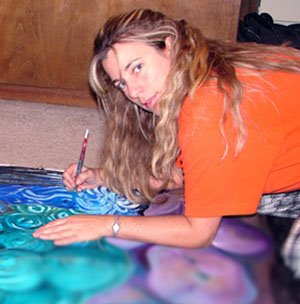 If the drive through the Palouse doesn't inspire your feelings of belongingness to our uniquely western landscape, perhaps these painters will
If the drive through the Palouse doesn't inspire your feelings of belongingness to our uniquely western landscape, perhaps these painters will
October 16 – December 5, 2009
Six innovative contemporary painters from four different Western States exhibit work featuring diverse approaches to technique and media.
Squeak Carnwath--A UC professor whose work comes across as a cross between outsider and Pop Surreal, with a hint of lyricism. She works in sculpture, but mostly painting and also printmaking, layering and interweaving images, works, icons and symbolism in a deceptively unschooled-looking, flattened style. Right: Fly, Fight, Fugit.
Roll Hardy--Portland artist whose unsentimental paintings of detritus-filled spaces capture the quiet drama of urban places in transition. Devoid of people, the impact of humans on his landscapes are nonetheless everpresent. There's often a surreal light quality and hazy paint-handling that lends to their overall feeling of inevitable evolution.
Travis Ivey--A younger Wyoming painter whose earlier realistic style has evolved to address the impact of human development on the formerly wide open lands of his native state. Fences, oil rigs and other signs of humanity invade Ivey's distinctly western landscapes.
Mary Josephson--Also from Portland, Josephson's works channel Frida Kahlo's subject matter and outsider-art approach to the figure, with a little bit of Picasso, perhaps. There's an apparent joyfulness to her color use that is undermined by what feels like analytical distance or maybe even skepticism. The results are portraits that attempt to get at the elusive inner quality of the subject.
Kasey Keeler--With a background in Wyoming, New Mexico and Montana, there is an openness to her work that reflects the sense of space we traditionally associate with the west. Yet there is nothing sentimental about her use of color and shape. Instead her style tends toward consummately painted, luscious surfaces that are extremely conscious of the fragile balance between the land and steward.
Michael Schultheis--From his home in Seattle, this cerebral artist transforms color and shape into mathematical notations, resulting in abstract layerings of paint that still retain a sense of expressionist movement. If they were likened to landscapes, one could easily see the gray weight of a Seattle shoreline or the golden glow of a western sunset--albeit expressed in his enigmatic artistic script.


